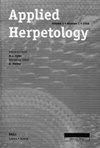Deformities in cane toad ( Bufo marinus ) populations in Bermuda: Part I. Frequencies and distribution of abnormalities
引用次数: 19
Abstract
Observations of abnormal adult cane toads ( Bufo marinus ) in Bermuda in 1998 prompted surveys of the island's mature and newly metamorphosed populations from 1999 to 2003. External examinations revealed eye and facial abnormalities, spinal and pelvic abnormalities, and a variety of limb malformations. Malformed toads were found in all nine of Bermuda's parishes and the incidence rate was high in both age classes. The annual abnormality frequencies were 19-30% for adults and juveniles, and 16-24% for metamorphs. Annual metamorph abnormality rates at particular ponds were as high as 58%, and abnormality rates for particular cohorts were as high as 81%. The frequency of hind limb abnormalities was significantly greater than that of forelimb abnormalities in both age classes. Most eye and limb abnormalities were unilateral. The most common limb malformation was brachydactyly, and few cutaneous fusions or examples of polymely were observed. Breeding sites that were natural or artificial ponds in parks or nature reserves, or lined ponds on golf courses, had significantly higher abnormality frequencies than lined or cement ponds in backyard settings. No encysted Ribeiroia metacercariae were found in 80 malformed metamorphs collected from four sites with high abnormality rates, suggesting that these parasites were not responsible for the malformations observed. Frog embryo teratogenesis assays demonstrated that water and sediment extracts from the same four breeding sites induced severe developmental malformations in B. marinus and three other amphibian species. These data suggested that many B. marinus breeding sites in Bermuda are potentially contaminated with developmental toxicants.百慕大蔗蟾蜍(Bufo marinus)种群的畸形:第1部分:畸形的频率和分布
1998年在百慕大观察到的异常成年甘蔗蟾蜍(Bufo marinus)促使1999年至2003年对该岛成熟和新变形的种群进行调查。外部检查显示眼睛和面部异常,脊柱和骨盆异常,以及各种肢体畸形。在百慕大所有九个教区都发现了畸形蟾蜍,两个年龄组的发病率都很高。成虫和幼虫的年异常频率为19-30%,变质虫的年异常频率为16-24%。特定池塘的年变态异常率高达58%,特定队列的变态率高达81%。两年龄组后肢异常发生率均显著高于前肢异常发生率。大多数眼睛和肢体异常是单侧的。最常见的肢体畸形是短指畸形,很少观察到皮肤融合或息肉的例子。在公园或自然保护区的天然池塘、人工池塘、高尔夫球场的衬砌池塘中,异常频率显著高于后院衬砌池塘或水泥池塘。在4个异常率较高的部位采集的80例畸形变形中未发现囊性里贝罗囊蚴,提示这些寄生虫与所观察到的畸形无关。青蛙胚胎畸形实验表明,来自相同四个繁殖地的水和沉积物提取物可导致海蛸和其他三种两栖动物的严重发育畸形。这些数据表明,百慕大的许多海洋白鲟繁殖地可能受到发育毒性物质的污染。
本文章由计算机程序翻译,如有差异,请以英文原文为准。
求助全文
约1分钟内获得全文
求助全文

 求助内容:
求助内容: 应助结果提醒方式:
应助结果提醒方式:


